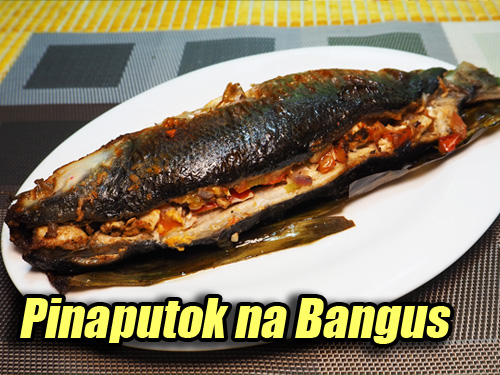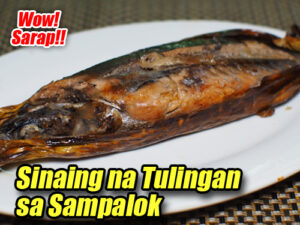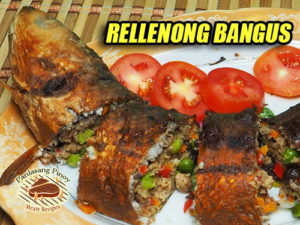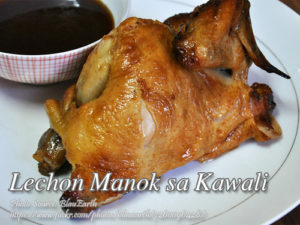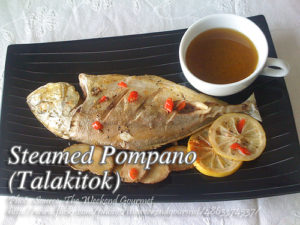This pinaputok na bangus recipe is similar to the pinaputok na tilapia and the method of cooking is quite the same. Which is, by stuffing the fish with the combination of onion, tomatoes, patis, celery and ground pepper then wrapping it with banana leaves and frying it. This dish version uses bangus as a substitute to tilapia and with one additional ingredient, that is, the salted egg. You will be amazed with just one simple ingredient will make this dish level up to the next level of deliciousness. I also didn’t expect the improvement of the taste when I first tried it. Just don’t forget to cook a lot of rice when you serve it because when your family or friends tasted it, they ask for extra rice! No kidding!
Pinaputok na Bangus with Salted Egg: A Nostalgic Dish to Savor
Growing up in a small fishing town in Batangas, meals with fresh seafood were a regular treat. My uncle Ramon, who was a fisherman, would often bring home the freshest bangus caught at dawn, still glistening with the ocean’s dew. It was during one of these visits that I first learned about pinaputok na bangus, a dish so flavorful that it became a staple in our family gatherings.
Back then, my aunt Gloria had a knack for experimenting with traditional recipes. She would take inspiration from her neighbors, adding her own twist to elevate a dish. One summer afternoon, she replaced tilapia with bangus and sneaked in salted egg into the stuffing. The result was a masterpiece that had everyone lining up for seconds—and thirds.
What is Pinaputok na Bangus?
The term “pinaputok” literally means “to explode” or “to burst,” referring to how the flavors burst out of the fish once cooked. The dish is traditionally made by stuffing the fish with a savory medley of tomatoes, onions, celery, and spices. It’s then wrapped in banana leaves and fried to perfection. Adding salted egg takes this classic recipe up a notch, lending it a creamy, slightly briny flavor that complements the richness of the milkfish.
This version of pinaputok na bangus has a unique twist that brings out the flavors of home. The salted egg not only enhances the dish but also introduces a nostalgic note, as salted egg often reminds Filipinos of childhood meriendas and local delicacies like bibingka.
Preparing the Bangus: A Step Towards Perfection
The first step in making pinaputok na bangus is preparing the fish itself. My mother taught me how to butterfly a bangus, carefully cutting along the dorsal side and removing the scales, innards, and bones. This process, though meticulous, ensures a clean, tender base to absorb all the delicious stuffing. Washing and drying the fish properly is a small but crucial step—it prevents excess water from interfering with the frying process and allows the fish to crisp up beautifully.
The stuffing is where the magic happens. A combination of salted egg, onions, tomatoes, celery, patis, and ground black pepper creates a vibrant mix of flavors. The salted egg adds a velvety richness, while the tomatoes bring a juicy, tangy note. My cousin Teresa swears by the addition of celery, which lends a fresh, herbaceous aroma that balances the richness of the bangus.
Wrapping in Banana Leaves: Tradition Meets Technique
Using banana leaves to wrap the fish is more than just a practical step; it’s a nod to Filipino culinary traditions. The leaves act as a natural wrapper, locking in moisture and infusing the dish with a subtle, earthy aroma.
I remember my lola patiently wiping banana leaves clean and gently warming them over an open flame to make them pliable. This step is essential, as it prevents the leaves from tearing when you wrap the fish. Once the bangus is stuffed and folded, the banana leaf is tied securely to hold everything in place during cooking.
The Art of Frying: Crisp and Flavorful
Frying the wrapped fish is where the dish truly comes to life. As the oil heats up, you can hear the gentle sizzle and the occasional “pop,” a sign that the banana leaf is working its magic. Covering the pan immediately is a must—my kuya learned this the hard way when he ended up with a kitchen full of oil splatters!
The banana leaf creates a protective barrier, allowing the fish to cook evenly while sealing in all the delicious juices. The salted egg melts into the stuffing, creating a creamy, flavorful filling that pairs beautifully with the tender, flaky bangus.
A Dish That Brings People Together
Serving pinaputok na bangus always feels like a celebration. The fragrant aroma of banana leaves, the vibrant colors of the stuffing peeking through, and the crispy skin of the fish make for an impressive centerpiece. Pair it with a generous serving of steamed rice and a side of calamansi-soy dipping sauce, and you’re guaranteed to win everyone’s hearts—and appetites.
This dish has become a family favorite not only because of its flavor but also because of the memories it evokes. Every time I prepare it, I’m reminded of lazy afternoons by the sea, the sound of laughter around the dinner table, and the love poured into every bite.
A Quick History of Pinaputok na Bangus
While pinaputok na bangus has become synonymous with Filipino comfort food, it’s believed to have evolved from the traditional ways of cooking fish in the provinces. Wrapping food in banana leaves is a technique deeply rooted in Philippine culinary history, dating back to pre-colonial times. It’s a simple yet ingenious way to enhance flavors while keeping dishes moist and aromatic.
The addition of salted egg, however, is a modern twist, reflecting the Filipino love for fusing traditional and contemporary flavors. This combination showcases the creativity and adaptability of Filipino cuisine, making it both timeless and exciting.
A Dish Worth Trying
Whether you’re a beginner in the kitchen or a seasoned cook looking for something new, pinaputok na bangus with salted egg is a dish worth adding to your repertoire. It’s easy to make, deeply flavorful, and steeped in tradition. More importantly, it’s a dish that brings people together, reminding us that food is more than sustenance—it’s a way to share love, stories, and heritage.
So the next time you crave a taste of home, try your hand at this recipe. Just be sure to cook extra rice—you’ll need it!
How to Cook Pinaputok na Bangus
Ingredients
- 1 piece medium size bangus butterflied, innards, gills, bones and scales removed
- 1 piece salted egg chopped
- 1 piece red onion chopped
- 2 pcs ripe tomatoes chopped
- 1 stalk celery chopped
- 1/2 tsp. ground black pepper
- 1 Tbsp. patis
- banana leaf for wrapping
- cooking oil for frying
Instructions
How to Cook Pinaputok na Bangus:
- Cut the bangus at the dorsal or back side from head to tail. Then clean it by removing scales, bones, innards and gills.
- Wash and drain and put in the colander to drain excess water until dry.
- In a bowl, combine chopped salted egg, onion, celery, tomatoes, patis and ground black pepper.
- Cut a piece of banana leaf into 1 foot long then wash and wipe dry. Lay the banana leaf on a clean surface.
- Put the butterflied bangus on top of the banana leaf. Then stuff it with the tomatoes-salted egg mixture by putting it in the center of the fish from head to tail.
- Fold the bangus to wrap the mixture and roll it in the banana leaf to wrap the fish.
- Tie the head, tail and the center part of the fish with pieces of banana leaf.
- Heat 2 to 3 cups of cooking oil in a big wok or kawali that can fit the bangus.
- Put in the bangus and fry then cover immediately to avoid oil splatters. Fry until the cracking noise of the hot oil is almost gone.
- Then turn the fish to fry the other side also. When cooked, remove from the wok and transfer to a plate.
- Remove the banana leaf from the fish and serve hot with your favorite dipping sauce or side dish.
Video
Notes
Cooking Tips:
Properly Clean and Butterfly the Bangus
To ensure a delicious pinaputok na bangus, thoroughly clean the fish by removing the scales, bones, innards, and gills. Make a precise cut along the dorsal side to butterfly the bangus, creating enough space to hold the flavorful stuffing. A well-prepared fish absorbs the stuffing’s juices better, resulting in a tender, flavorful dish.Use Fresh and Quality Ingredients
For the best flavor, choose fresh bangus and ripe, juicy tomatoes for the stuffing. Incorporate high-quality salted egg to add a creamy, briny touch that elevates the dish. Fresh banana leaves are also essential, as they infuse the fish with a subtle, earthy aroma during cooking.Secure the Wrap Tightly Before Frying
Wrap the stuffed bangus snugly in banana leaves to lock in the moisture and flavors while frying. Use strips of banana leaf to tie the head, tail, and center of the fish securely, preventing the stuffing from spilling out. This technique ensures the fish cooks evenly and maintains its shape for a beautiful presentation.
